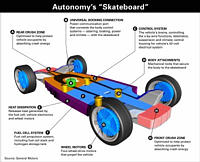Hydrogen Powered Future Unveiled By GM
FOR RELEASE: January 7, 2002Hydrogen In, Water Out - Clearly, The AUTOnomy Is Clean
DETROIT- The hydrogen-powered future just became easier to imagine with the introduction of General Motors' AUTOnomy concept vehicle. It would run cleaner, use fewer resources and conceivably last twice as long as conventional vehicles.
Fuel cell vehicles consume hydrogen, the most abundant element in the universe, and emit only water vapor and heat. Emissions such as carbon dioxide are removed from the picture.
However, AUTOnomy is much more than just a clean air vehicle. The GM concept provides much more value than just zero emissions and twice the fuel economy.
"Customers want better fuel economy and a cleaner environment," said Larry Burns, GM's Vice President of Research and Development and Planning. "However, they do not expect to pay more for sustainable mobility. It is incumbent on the auto industry to invent vehicles that are sustainable but do not impose tradeoffs on customers."
Government also plays a critical role, Burns said. Consumer tax incentives, for instance, would help overcome the higher initial costs of advanced technologies and create consumer demand for vehicles that include them, he said.
"AUTOnomy would also be attractive for benefits people don't even associate with fuel cells," Burns added "It would provide very affordable all-wheel drive, unprecedented safety and comfort, re-configurable interiors, multiple bodies for differing needs, no oil changes, maintenance worries or trips to the gas station."
The chassis also could serve as a mobile energy source, providing heat and electricity for your home, he said.
"That's what will make fuel cell vehicles sell, not the environmental benefits alone. That's what we need to move to a hydrogen economy and the day when the automobile is completely removed from the environmental equation," Burns said.
The skateboard chassis, which includes the propulsion system, fuel storage, brakes, steering and other critical systems, is intended to last up to 20 years.
With a longer service life, AUTOnomy will reduce manufacturing waste and will potentially be easier to recover and recycle than today's vehicles. The body also can be made of recycled materials.
The drive-by-wire technology replaces mechanical systems with electronic ones, eliminating the need for engine oil, transmission fluid or brake fluid. That would further reduce the environmental impact of the automobile.
"Long term, this is the best solution for customers, government, industry and environmentalists," Burns said. "Policy makers in the U.S. and around the world need to give serious consideration to the power of an idea such as AUTOnomy. It is a catalyst for bringing about a hydrogen economy.
"People will buy these cars because they are passionate about them and they offer a better value than today's technology."



